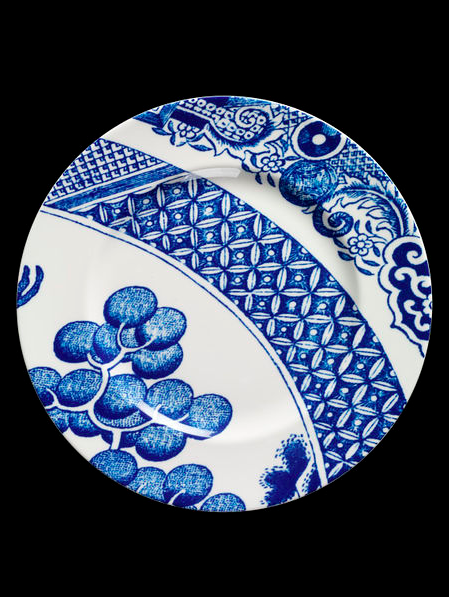
December 17, 2014
Inherited China

Unlike traditional European-designed dinnerware, Kilta’s plates and bowls are not ornamented. Not even the slightest cheerful posey or decorative fleur-de-lis peeps from the rigid geometry of Franck’s cups. In shunning European decorative traditions, Franck intended to empower the postwar consumer: the informal, interchangeable pieces could be assembled at will to serve the needs of the present. The plainness and affordability of the popular dinner service was intended as an erasure of pretention, history, and tradition. In the 1950s, Kilta offered European consumers a way to move forward, to forget the total devastation of recent years, if only in the act of setting the table.

For diners who dislike the visual experience of witnessing flora and fauna emerge from beneath their salad, Kilta/Teema continues to offer a welcomingly blank canvas from which to eat a meal. In fact, the plain geometry of both series heightens the aesthetic intensity of the object it presents, be it a cucumber slice or a Twinkie. (In case you are wondering, Twinkies were created in the Midwest in the early 1930s, making them older than both Lego and Kilta.)
The passage of time continues to be of essence at the dinner table. In a reversal of attitudes from Franck’s day, current ceramic artists and tableware designers are embracing the past with enthusiasm.
A new conversation has emerged, with its own distinctive sense of playfulness—for, in fact, much of this new work is funny, but the play is not open-ended: designers are focusing the conversation on specific patterns, forms, and issues. Designers like London-based Robert Dawson and Helsinki’s Caroline Slotte are among an international cohort of artists who sample, distort, and redesign eighteenth- and nineteenth-century dinnerware patterns to create new works which can surprise and delight a generation raised on modernist seriousness. (Exhibitions of work in this vein include The New Blue and White at the MFA Boston and a forthcoming show at the Victoria and Albert Museum.)
Other contributors to the dialogue include Australian Robin Best, China’s Xue Lei, and the Stockholm-based collaborative Front, signaling a global interest in bringing back the past to the table. The best of the new work is intelligent, provoking viewers and users—for it is produced as both gallery installations and commercial tableware—to interrogate the history of European ceramic production and the global ceramic trade. The mood of most of this work, which began to appear in the 1990s, is irreverent and ironic, suggesting a critical detachment from the images of birds, bridges and boats, which float across its plates, cups and saucers. It is now almost cliché to design dinnerware which appropriates patterns from seventeenth- and eighteenth-century European dinnerware.
Even IKEA is finally in on the game—evidence, no doubt, that the movement may have come to its logical conclusion. The most compelling pieces in this new body of work raise valid questions about ceramic design and the role of tradition at the table. However, the new work frames a line of inquiry which is much more directed than Franck’s open-ended Kilta project. As in other areas of inquiry, universality has been abandoned; self-referential, intra-disciplinary work is prized.

After Willow dinnerware is sold by an established manufacturer to a discerning, if self-aware, audience. To employ After Willow at the dinner table is to signal a sophisticated appreciation for Dawson’s knowledge of British history as well as his insouciance. The social use of the series is not so far removed from that of the original Meissen, Sevres, or Wedgwood. Dawson’s tabletop narrative, like much of the work produced by the new blue and white artists, is focused on British history, the history of image exchange and object production within an industry. The plate itself does not change anything about the individual’s physical encounter with food. Dawson’s ironic, detached attitude is clever, but subtly prompts the user to follow the artist’s line of thought, rather then inviting the user to open a new conversation.

To see Slotte’s work, a viewer has to stand in a specific place; these are not works which can be used at the table. The traces which she excavates are of course imaginary, produced by Slotte’s own drilling, rather than the actual traces of individual diners—those people and their dreams, meals, and ideas remain stubbornly unknown. (Slotte has also done a series in which she experiments with the power of food residues to produce recognizable patterns on ordinary china.) Slotte is as present in her work as Franck intended to be absent from his. Her work is imperfect, incomplete, of a particular time; he intended his to be anonymous, flawless, and comprehensive.
IKEA’s blue and white plates, which feature fragments of traditional designs interspersed with small hot air balloons, are clearly nonsense. Dawson, Slotte, and others raise good questions about the ceramic trade and the extent to which patterns and traditions can be manipulated to serve the whims of the present. 


Franck’s Teema, like all abstraction, remains frustratingly mute. But like Godtfredt Kirk Christiansen’s original Lego (the word means “good play”), the circles and squares of Franck’s dishes and plates leave the conversation open.
Observed
View all
Observed
By Victoria Solan
Related Posts

Business
Courtney L. McCluney, PhD|Essays
Rest as reparations: reimagining how we invest in Black women entrepreneurs

Design Impact
Seher Anand|Essays
Food branding without borders: chai, culture, and the politics of packaging

Graphic Design
Sarah Gephart|Essays
A new alphabet for a shared lived experience

Arts + Culture
Nila Rezaei|Essays
“Dear mother, I made us a seat”: a Mother’s Day tribute to the women of Iran
Recent Posts
Courtney L. McCluney, PhD|Essays
Rest as reparations: reimagining how we invest in Black women entrepreneurs Food branding without borders: chai, culture, and the politics of packaging Why scaling back on equity is more than risky — it’s economically irresponsible Beauty queenpin: ‘Deli Boys’ makeup head Nesrin Ismail on cosmetics as masks and mirrorsRelated Posts

Business
Courtney L. McCluney, PhD|Essays
Rest as reparations: reimagining how we invest in Black women entrepreneurs

Design Impact
Seher Anand|Essays
Food branding without borders: chai, culture, and the politics of packaging

Graphic Design
Sarah Gephart|Essays
A new alphabet for a shared lived experience

Arts + Culture
Nila Rezaei|Essays
